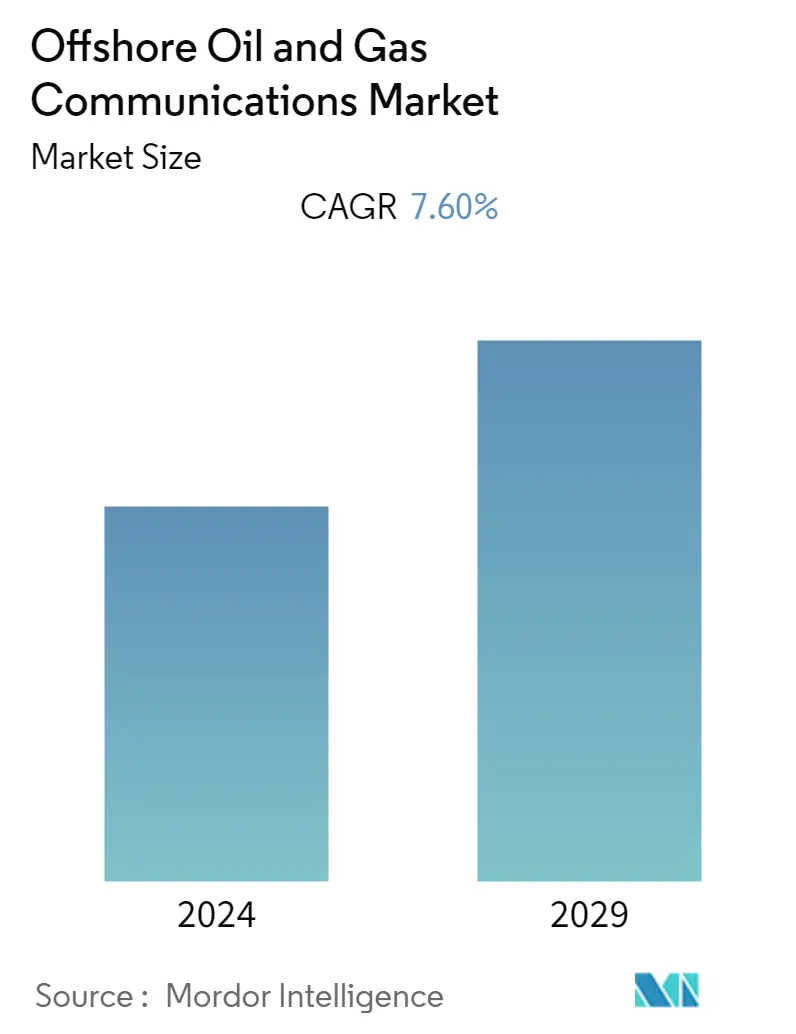Market Size of Offshore Oil & Gas Communications Industry

| Study Period | 2019 - 2029 |
| Base Year For Estimation | 2023 |
| CAGR | 7.60 % |
| Fastest Growing Market | Asia-Pacific |
| Largest Market | North America |
| Market Concentration | Medium |
Major Players
*Disclaimer: Major Players sorted in no particular order |
Offshore Oil and Gas Communications Market Analysis
During the time frame of the forecast, the offshore oil and gas communications market is anticipated to register a CAGR of 7.6%.During the forecast period, the market is expected to grow because the oil and gas industry is investing more in new technologies and digital technologies.
- From the oil rig to the offshore platforms, it's important to have good oil and gas communication equipment for safety and efficiency. A good communication system does more than just send data between businesses that are offshore and those that are onshore.
- Offshore rigs are comparatively hard to establish, operate, and maintain. They must deal with environmental factors, including strong ocean currents and highly remote environments. Most of them are deep-water rigs that operate at great depths. In such remote locations, communications play a major role in monitoring several components and staying in contact with onshore establishments for reporting and assistance in emergencies.
- Several different communication technologies can now work alone or as a system to solve communication problems offshore. Satellite communications, which require a VSAT at the offshore site and are used by ships in remote places or that are moving, are the most common way to talk to people while offshore. Cellular networks are now being used in offshore oil fields because more money is being put into infrastructure there.
- Still, the offshore oil and gas field communications industry will be slowed down by worries about not enough data protection, risks in data transfer, asset security, and the difficulty of cyberattacks. Oil price volatility would even further slow the oil field communications sector's growth. The high expenses of maintaining this procedure will further limit the expansion of the oil field communications business.
- COVID-19 had an impact on the oil and gas industry as well. Everyone has had to adjust, from people being placed on leave to businesses having to radically rethink their long-term plans. Businesses must rethink their long-term strategies. When it comes to offshore oil rigs, the effect is more evident. The COVID-19 pandemic hindered offshore oil rig development and maintenance. Post-epidemic, the industry is expanding as it adopts new technology and new working methods, with companies adjusting to these new circumstances.
Offshore Oil and Gas Communications Industry Segmentation
Oil and gas communications systems provide critical voice and data services both locally on the various offshore assets used-such as drilling rigs and production platforms-and between the offshore sites and their onshore control centers.
Offshore communications in the oil and gas industry have come a long way. Now, real-time communications networks not only enable wi-fi connectivity and personal cell phone connections but also real-time data transfer from offshore to onshore offices located around the world.
The offshore oil and gas communications market is segmented by solution (upstream communication systems, midstream communication systems, and downstream communication systems), by communication network technology (cellular communication network, VSAT communication network, and fiber optic-based communication network), and by geography (North America, Europe, Asia Pacific, the Middle East, and Africa).
The market sizes and forecasts are provided in terms of value (in USD million) for all the above segments.
| By Solution | |
| Upstream Communication Systems | |
| Midstream Communication Systems | |
| Downstream Communication Systems |
| By Communication Network Technology | |
| Cellular Communication Network | |
| VSAT Communication Network | |
| Fiber Optic-based Communication Network | |
| Microwave Communication Network |
| By Geography | |
| North America | |
| Europe | |
| Asia-Pacific | |
| Latin America | |
| Middle East & Africa |
Offshore Oil & Gas Communications Market Size Summary
The offshore oil and gas communications market is poised for significant growth, driven by the industry's increasing investment in new and digital technologies. Effective communication systems are crucial for the safety and efficiency of operations on offshore rigs and platforms, which are often located in challenging and remote environments. These systems facilitate real-time monitoring and communication between offshore and onshore locations, essential for operational efficiency and emergency response. The market is experiencing a transformation due to advancements in communication technologies, such as satellite communications, cellular networks, microwave, and fiber-optic solutions, which have enhanced connectivity and data transmission capabilities. However, challenges such as data security concerns, cyber threats, and high maintenance costs pose potential obstacles to market expansion.
North America stands out as a leading market for offshore oil and gas communications, driven by new shale resource discoveries and ongoing oil and gas projects in the region. The demand for advanced digital solutions is expected to rise, fueled by increasing crude oil prices and expanded upstream activities. Key players in the market, including ABB Ltd., Alcatel Lucent SA, Baker Hughes Incorporated, CommScope Inc., and AT&T Inc., are leveraging partnerships, mergers, and acquisitions to enhance their offerings and maintain a competitive edge. Innovations such as Baker Hughes' acquisition of AccessESP and Alcatel-Lucent Enterprise's Purple on Demand service highlight the industry's focus on modernizing operations and providing secure, flexible communication solutions. As the offshore oil and gas sector continues to grow globally, the demand for robust communication systems is anticipated to increase, offering lucrative opportunities for market participants.
Offshore Oil & Gas Communications Market Size - Table of Contents
-
1. MARKET INSIGHTS
-
1.1 Market Overview
-
1.2 Industry Attractiveness - Porter's Five Forces Analysis
-
1.2.1 Threat of New Entrants
-
1.2.2 Bargaining Power of Buyers/Consumers
-
1.2.3 Bargaining Power of Suppliers
-
1.2.4 Threat of Substitute Products
-
1.2.5 Intensity of Competitive Rivalry
-
-
1.3 Industry Value Chain Analysis
-
1.4 Impact of COVID-19 on the Market
-
-
2. MARKET SEGMENTATION
-
2.1 By Solution
-
2.1.1 Upstream Communication Systems
-
2.1.2 Midstream Communication Systems
-
2.1.3 Downstream Communication Systems
-
-
2.2 By Communication Network Technology
-
2.2.1 Cellular Communication Network
-
2.2.2 VSAT Communication Network
-
2.2.3 Fiber Optic-based Communication Network
-
2.2.4 Microwave Communication Network
-
-
2.3 By Geography
-
2.3.1 North America
-
2.3.2 Europe
-
2.3.3 Asia-Pacific
-
2.3.4 Latin America
-
2.3.5 Middle East & Africa
-
-
Offshore Oil & Gas Communications Market Size FAQs
What is the current Offshore Oil & Gas Communications Market size?
The Offshore Oil & Gas Communications Market is projected to register a CAGR of 7.60% during the forecast period (2024-2029)
Who are the key players in Offshore Oil & Gas Communications Market?
ABB Ltd, Alcatel Lucent SA, Baker Hughes Incorporated, CommScope Inc. and AT&T Inc. are the major companies operating in the Offshore Oil & Gas Communications Market.

